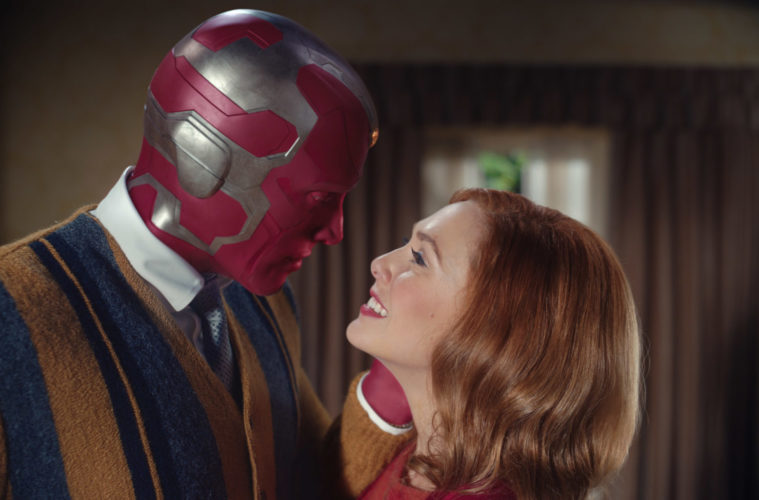Already brimming with magic and mayhem, super-charged superheroes, and enough drama to fill a world or two, the Marvel universe is about to get much, much bigger. And it’s all thanks to a little witchcraft.
While the Marvel Cinematic Universe’s production schedule is currently on pause due to the pandemic, the Mouse House did take the opportunity in January to roll out WandaVision on Disney+ and the series has not only acted as an in-depth examination into the life of a lesser-explored Avenger, it also forms the connective tissue that will help introduce major themes and concepts for Phase Four of the MCU.
But before exploring the future of Phase Four, an examination of Marvel’s history and its ability to break down comic book lore is needed. Beginning with Iron Man in 2008, Marvel’s film release was divided into distinct sections, each with themes and storylines that would encompass a massive overarching world in which heroes from each movie converge, blending elements from each narrative.
Phase One introduced the core characters – Thor, Iron Man, Captain America and the Hulk – and ended in the crossover, The Avengers. Phase Two dug deep into the Marvel backpages for additional heroes such as Guardians of the Galaxy and Ant-Man, while establishing more complex themes and exploring conflict between the icons. Phase Three would see disputes between the heroes come to a head, initially splitting the super group, but later resolving their issues to fight a larger foe, Thanos. The phases allowed the audience to understand the heroes and their private battles, while inserting the drama necessary to allow the audience to become personally invested in each hero.
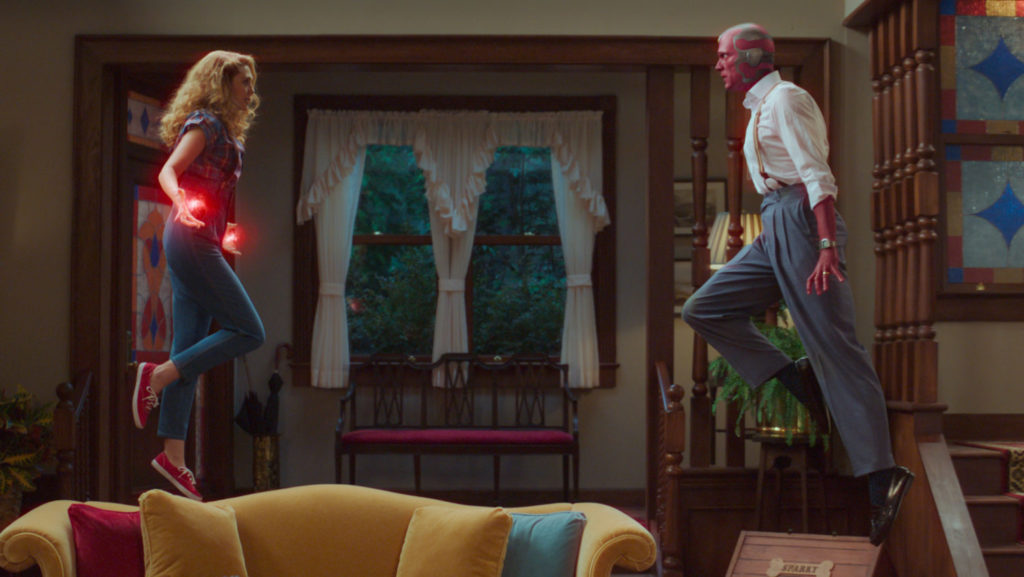
(Elizabeth Olsen as Wanda Maximoff and Paul Bettany as Vision in Marvel Studios’ WANDAVISION exclusively on Disney+. Photo courtesy of Marvel Studios. ©Marvel Studios 2021. All Rights Reserved.)
WandaVision is a culmination of the first three phases of the Marvel rollout, taking place after the events of Avengers: Endgame, which saw every hero from the MCU take the field to save the universe, ending with the loss of both Iron Man and Steve Rogers’ Captain America. In the end, the heroes who survived were left to pick up the threads of new storylines and kick off Phase Four.
When we last saw Wanda Maximoff (Elizabeth Olsen), aka the Scarlet Witch, she was one of the MCU’s most tragic figures. Orphaned at a young age and brainwashed to become a weapon by Hydra, Wanda has had more than her fair share of devastating sadness. First with the death of her parents, then her brother, followed by the loss of her lover Vision (Paul Bettany) at the hands of Thanos. But what of her whereabouts after the Avengers assembled to defeat the Mad Titan?
During this time, Wanda herself became darker and more dangerous as she was consumed by her grief. All alone after the battle with Thanos, Wanda has been left to fester, choosing to create her own reality instead of facing her demons.
Disney+’s WandaVision is a truly unique entry by the studio. Set within different decades and using TV tropes that caricature family-friendly programming of the past, the show also hides a sinister secret behind its catchy theme songs and canned laugh tracks. The series cloaks deeper themes and offers an enticing mystery that invites fans to play Encyclopedia Brown in the MCU as they wade through the dozens of Marvel-related references hidden in its parody commercials and set design.
Though never stated, Wanda Maximoff is one of the most important players in the Marvel universe. With powers that include telekinesis, energy manipulation and the ability to change the perception of reality, Disney’s Wanda is more powerful than originally conceived by Jack Kirby and Stan Lee’s comics back in 1964. Wanda not only manipulates reality, she holds the future of the MCU in her hands.
“I think WandaVision is setting out to do what every entry in the MCU attempts to do: first, to tell a good, interesting story, and second, to further develop the larger world and push the story of the Marvel shared universe forward,” states TV host/Marvel guru Hector Navarro. “But WandaVision also has another agenda: to finally and fully showcase the potential of the Scarlet Witch and the Vision.”
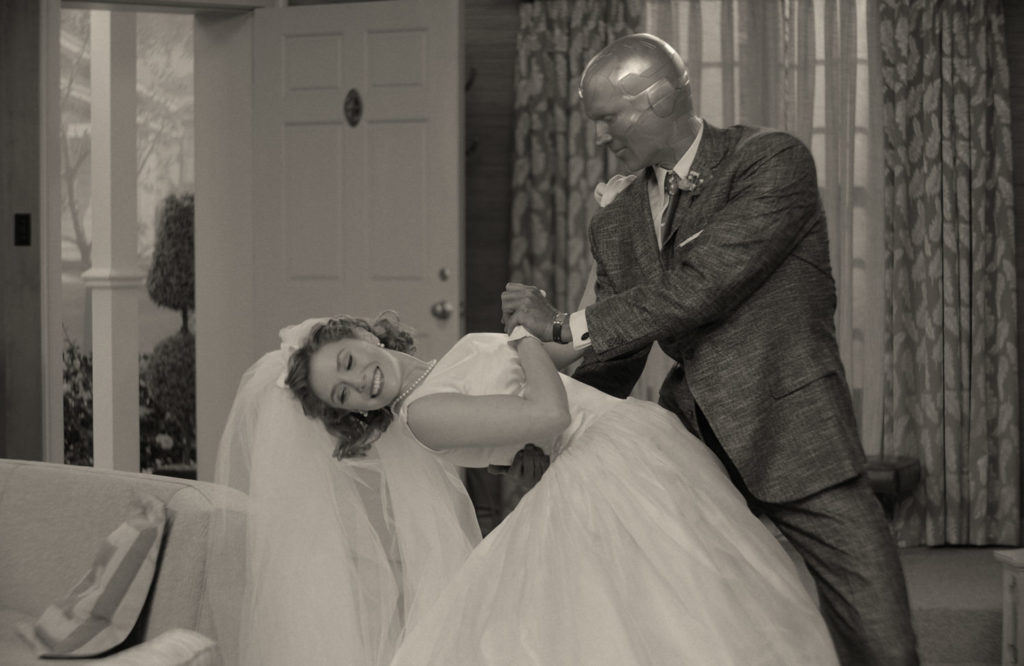
(Elizabeth Olsen as Wanda Maximoff and Paul Bettany as Vision in Marvel Studios’ WANDAVISION exclusively on Disney+. Photo courtesy of Marvel Studios. ©Marvel Studios 2020. All Rights Reserved.)
“It seems like their goal is to blow the doors off the Multiverse, bring more of the magical and the mystical into the MCU, and finally establish Wanda’s true power as one of MCU’s most-formidable beings,” adds John Humphrey, co-host of entertainment-driven YouTube channel, The Reel Rejects. “Based on the show, so far (and if the internet is to be believed), WandaVision appears to be a springboard for opening up the multiverse within the MCU as well as further expansion on the magical and mystical elements introduced in films like Doctor Strange.”
In addition to continuing the ongoing superhero saga, WandaVision also feeds fans bite-size nuggets of necessary information in a colorful way that is easy to digest. Taking a tip from the storytelling structure of comic books, the MCU uses information gathered from previous films to set up future endeavors.
With WandaVision, as well as its upcoming slate of new television shows, Marvel is leaning into Disney+ to help set up the future phases of the MCU by introducing audiences, slowly, to new concepts and ideas that will propel upcoming storylines.
“Classic comic book storylines like ‘Avengers: Disassembled’ or ‘House of M’ couldn’t really play out in the film franchise the way it was set up before,” states Navarro. “But with the addition of Disney+ series’ they can take their time exploring more character dynamics and relationships. Wanda losing her grip on reality (and eventually coming back from those extremes) is now a story that can be properly told in the Marvel Cinematic Universe.”
By using its television efforts to support its theatrical endeavors, Marvel is creating an active entertainment experience that both engages viewers while steadily teaching them everything they need to know for the next film. It’s homework, but without the work.
The slow introduction of information and world building is what sets the MCU – and its visionary guru Kevin Feige – apart from other franchises. Feige – who has been president of Marvel Studios and the primary mind behind the MCU since 2007, earning a combined worldwide box office gross of over $26.8 billion for the franchise – has assembled a team of writers and directors who understand that fans need to be entertained as they learn, otherwise the story can become muddled as they struggle to retain all of the new details thrown at them. Because of this method, fans who follow it all walk into every Marvel film completely prepared, armed with the knowledge of Pym Particles and how time transpires in the Quantum Realm. These days, more MCU-versed moviegoers understand the importance of returning the Infinity Stones to the point of origin rather than the Pythagorean theorem.
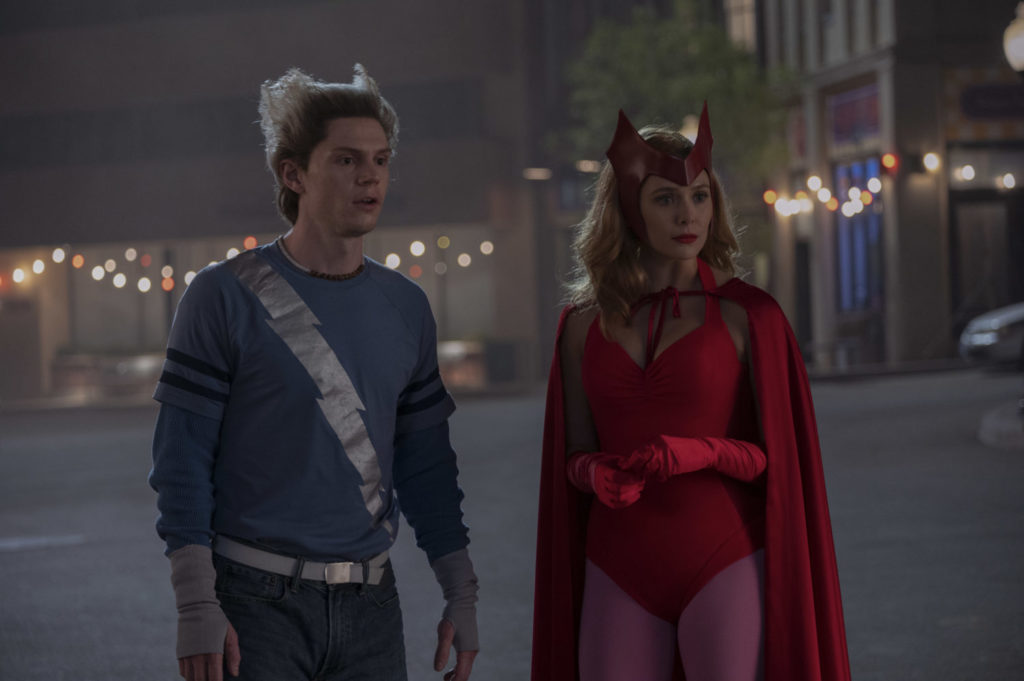
(Evan Peters as Pietro and Elizabeth Olsen as Wanda Maximoff in Marvel Studios’ WANDAVISION exclusively on Disney+. Photo by Suzanne Tenner. ©Marvel Studios 2021. All Rights Reserved.)
“It’s been fascinating to watch them build this apparatus over time, because its origins with Phase One are simple enough; but as the phases pick up momentum, you can see that, rather than simply adapting a certain story or character, they’ve managed to adapt an entire mode of storytelling,” explains Humphrey.
On WandaVision, the inclusion of Evan Peters as Wanda’s brother Quicksilver in lieu of the MCU’s Aaron Taylor-Johnson paves the way for Phase Four as it introduces the multiverse concept, while making the most out of the Fox and Disney merger. While the character was revealed to be a bit of a misdirection for the story, it still paves the way for the future. Not only does the cameo open the door to previous out-of-touch elements of the MCU, but it foreshadows the future of Marvel.
The Marvel Multiverse is the perfect opportunity to flex Disney’s muscle and to show off its brand new shiny acquisition: Fox. It also gives the MCU the ability to mix and match characters from different franchises that previously were out of bounds. “It seems fairly clear the multiverse is now in play in the MCU,” notes Mike Avila, author and host of the comic book video series Behind The Panel. “The multiverse provides rather easy yet fascinating options for introducing the X-Men and the Fantastic Four into the MCU.”
“I think WandaVision’s success, combined with The Mandalorian, has proven the viability of the weekly release,” adds Avila. “The global popularity of Marvel almost guarantees each new episode of a series will dominate social media conversations. In this age of instant gratification where viewers can watch what they want when they want, Disney+ has figured out a way to revive appointment TV viewing.”
WandaVision’s inclusion of Fox’s X-Men characters, as well as magic user/wicked witch Agatha Harkness (played by Kathryn Hahn), lays the multiverse groundwork for the upcoming Doctor Strange in the Multiverse of Madness and possibly Spider-Man 3: No Way Home, which is set for a December release. Feige has implied that WandaVision would most likely be a lead-in for the upcoming Doctor Strange movie.
“Some of the shows that I mentioned that we are about to start filming, we are keeping in mind a structure that would lead into a season two or a season three in a more direct way compared to a show like WandaVision that goes into a feature,” he explained at the Television Critics Association’s 2021 presentation.
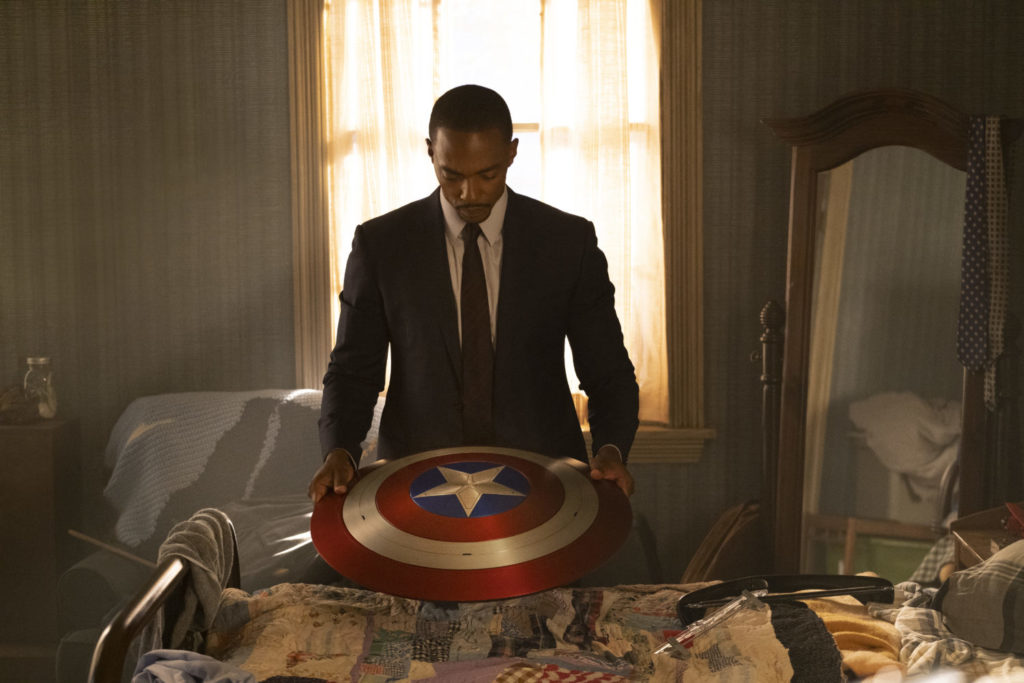
(Falcon/Sam Wilson (Anthony Mackie) in Marvel Studios’ THE FALCON AND THE WINTER SOLDIER exclusively on Disney+. Photo by Chuck Zlotnick. ©Marvel Studios 2020. All Rights Reserved.)
But as Marvel likes to keep its plot points close to the vest, all fans can do is theorize, hypothesize and speculate while they tune in week after week, thus creating a more loyal audience for Disney+. Co-executive producer Mary Livanos believes that the show’s current momentum is not just due to this kind of loyalty to the MCU, but also thanks to the compelling story at the heart of the show.
“One of the beautiful things about WandaVision is that it was really designed as its own, standalone complete story,” Livanos shares. “As far as how this story relates to future installments, we always knew that Wanda would segue into Doctor Strange and the Multiverse of Madness. The inclusion of Monica Rambeau and ties to Captain Marvel 2 was an early discovery that has been so cool to help build to. Each case of connectivity is an ever evolving creative conversation that is designed to enhance how this installment of the story resolves, rather than fundamentally change it. As for lasting ramifications on future phases, the hope is that there are kernels of inspiration and story threads introduced here that help weave the larger tapestry in later installments, if and when the narrative alchemy is right.”
It should be noted that the success of WandaVision not only comes from the strength of the franchise, but from the pandemic as well. Due to the sheer numbers of at-home people consuming content, it had a literal captive audience in which to show off its wonders. Disney CEO Bob Chapek is using the opportunity to create a new focus that will lean into streaming, much like he did two decades prior when he created Disney’s home video empire. But instead of Air Bud, Chapek has an entire MCU to play with. This new strategy will strengthen the symbiotic relationship between Disney+ and theatrical, feeding each other with each new release.
Marvel is moving full steam ahead with its small screen slate too. Up next is The Falcon and the Winter Soldier on March 19, with Anthony Mackie and Sebastian Stan reprising their Avengers roles. Much like WandaVision, the limited series will give the Avengers B-team a chance to shine as the duo try to find their place in a Captain America-less world. Like WandaVision, the series will take full advantage of its small-screen format to both tell a story while developing characters for their new roles in the MCU.
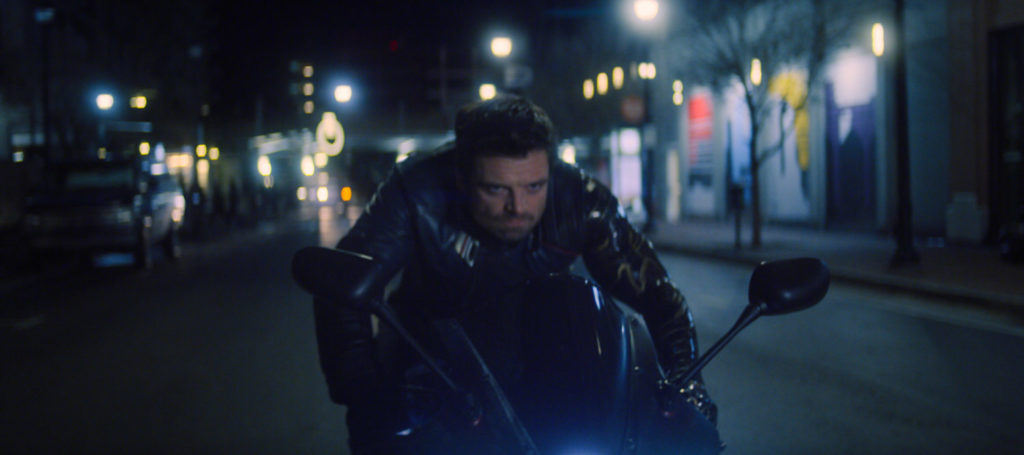
(Winter Soldier/Bucky Barnes (Sebastian Stan) in Marvel Studios’ THE FALCON AND THE WINTER SOLDIER exclusively on Disney+. Photo courtesy of Marvel Studios. ©Marvel Studios 2021. All Rights Reserved.)
“The value of these series is that we get to spend a lot more time with these characters – we get to go deeper into their relationships, their fears, their wants, and have some fun putting them in unexpected environments,” reveals The Falcon and the Winter Soldier co-executive producer Zoie Nagelhout. “It also means we have the time to invite supporting characters into their narratives, which not only makes the world of the show feel bigger, but also it adds layers to both Sam and Bucky as people. We get to understand them and the events of the show through multiple lenses.”
Following The Falcon and the Winter Soldier is Loki, which will debut in June. In his own outing, the God of Mischief (Tom Hiddleston) will likely use the serial format to establish his place within the new Marvel Universe. The series will also introduce the Time Variance Authority, a policing body from the comics that monitors the multiverse.
Following Loki, Hawkeye eyes a late 2021 release, while Ms. Marvel also targets late 2021 for a debut. In addition to these character-driven series, the animated anthology series What If…? is set for a Summer 2021 release, unless unforeseen circumstances push it back. The series will tease endless possibilities of each hero and storyline by placing characters in oddball situations. Other Marvel series that are set for production (but are a bit far off) include She-Hulk in 2022 plus Moon Knight, Ironheart and Secret Invasion, the latter three still TBA in terms of production release schedule.
In addition to Disney’s own slate, Marvel recently retained the rights to Punisher and Jessica Jones back from Netflix, officially ending the multi-year deal Disney held with the powerhouse streaming service. As Daredevil reverted back to Marvel in 2020, this gives Disney the possible chance to flex a little Defenders muscle.
“The production quality of the Marvel shows should be an indicator to broadcast networks that they shouldn’t bother to try to do a mainstream superhero show unless they plan to commit massive dollars to the effort,” states Avila. “ABC, NBC, CBS and certainly not the CW can compete with the types of production budgets Disney+ is giving to these Marvel shows.”
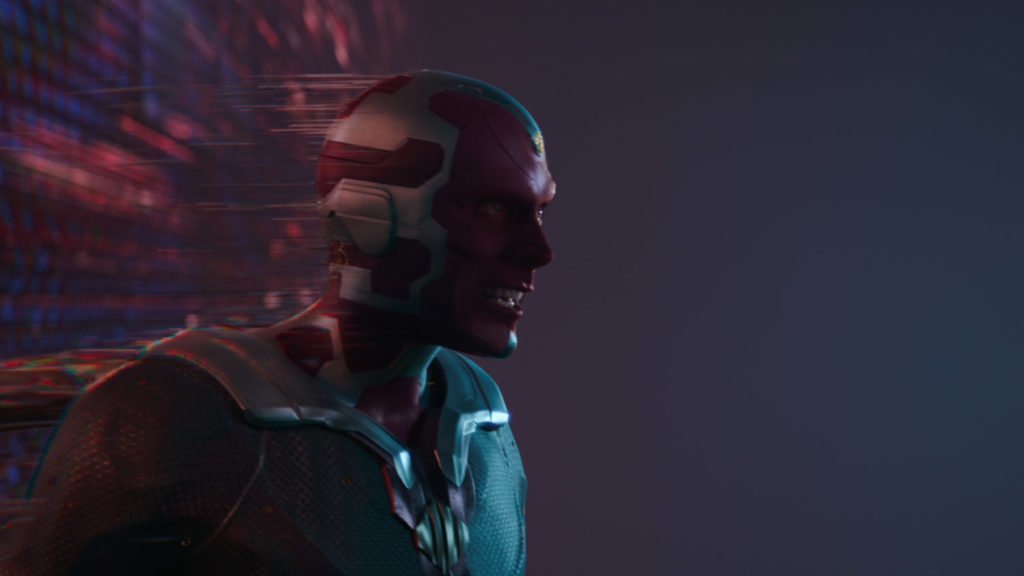
(Paul Bettany as Vision in Marvel Studios’ WANDAVISION exclusively on Disney+. Photo courtesy of Marvel Studios. ©Marvel Studios 2021. All Rights Reserved.)
With each new series, the strength of the Marvel franchise grows. Each series will connect in a larger way to the theatrical efforts, either through characters or plotlines, and each will help the other grow, creating a constant flow of entertaining content that also schools audiences on Marvel 101.
“The MCU coming to Disney+ continues to change the game with the expansion of an already vast and unprecedented narrative odyssey,” Livanos says. “To have Disney’s unwavering support in this space now allows the MCU to showcase and celebrate what we love best about television and the episodic format. It’s exciting to be at the precipice of all of the opportunities this unlocks.”
The small-screen series will pave the way for the ambitious theatrical slate that is just on the horizon, a slate that includes the much-delayed Black Widow (currently set for this May) and Shang-Chi and the Legend of the Ten Rings, set for July. This will clear the way for the highly-anticipated A-list extravaganza Eternals on November 5, 2021, which stars Angelia Jolie, Salma Hayek and former members of House Stark: Richard Madden and Kit Harington.
If all goes according to plan, the series slate will complement the nonstop theatrical releases set for 2022, including Doctor Strange in the Multiverse of Madness in March 2022 and Thor: Love and Thunder in 2022.
There’s not a lot known about Phase Five yet, but we do know that it will be marked by the release of Black Panther II in July of 2022, followed by Captain Marvel 2 in November of 2022. Other pics on the release schedule include Guardians Of The Galaxy Vol. 3 and Ant-Man 3, and the revamp of Blade. Then there is the possibility of new X-Men and Fantastic Four flicks.
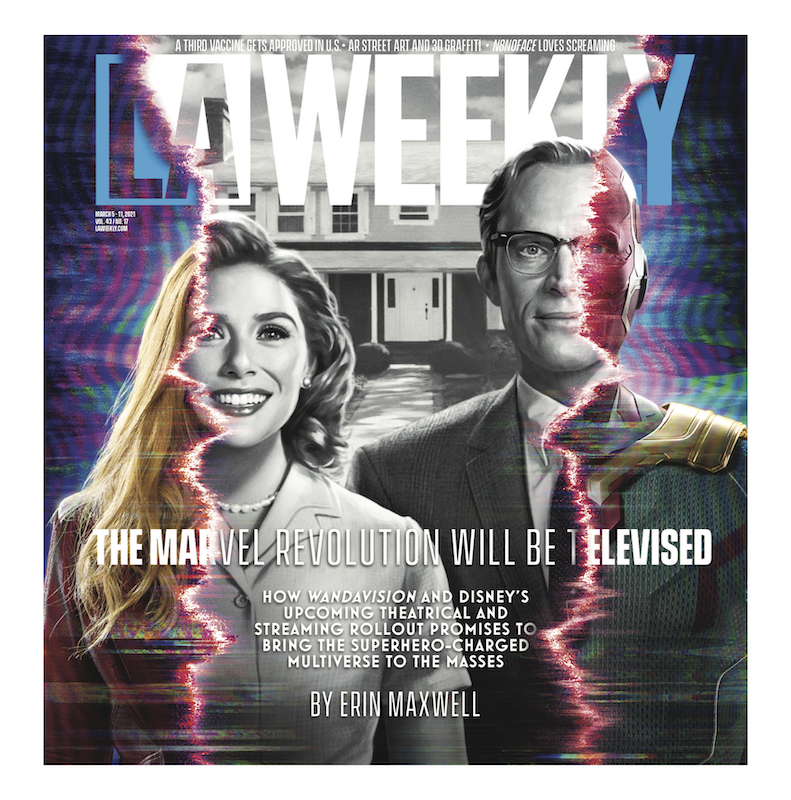
(This week’s LA Weekly cover story.)
In essence, Marvel is building a franchise more ambitious than anything ever attempted in pop culture. An entire universe spanning decades that includes television and theatrical releases, using every resource Disney has in its deep, deep pockets. The end result is a fully-formed world filled with compelling stories and favorite characters that will last the ages. Mainstream audiences can easily understand and appreciate it and hardcore fans can delve into it all in a deeper, nerdier way. In exchange, Disney gets a solid revenue stream and an unshakeable franchise that can result in more content, more fans, more theme parks, and a solid film and television slate for the next decade.
What Marvel is creating is not brand new, but it is revolutionary. A feat that has only been attempted on the pages of comics brought to screens of all sizes everywhere. And while the first step in this revolution might have started with an iron suit, credit to Marvel’s next phase must be given to a witch … and a little vision.
“Hold on to your hats, because WandaVision is just the beginning. The upcoming MCU Disney+ and theatrical slate is absolutely unlike anything audiences have seen before,” touts Livanos. “Knowing what’s cooking, there really does seem to be something for every kind of audience member to relate to and enjoy. Prepare for delight.”
WandaVision’s season finale airs premieres Fri., March 5 on Disney+.
Advertising disclosure: We may receive compensation for some of the links in our stories. Thank you for supporting LA Weekly and our advertisers.

